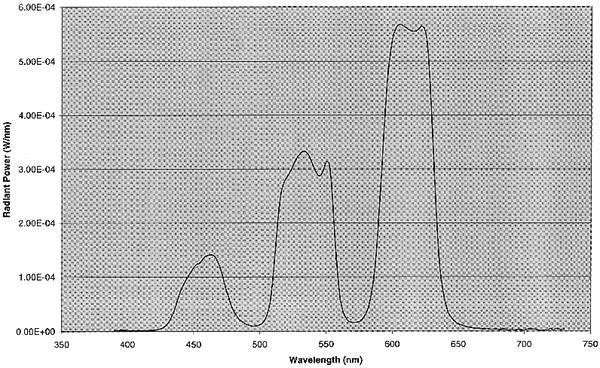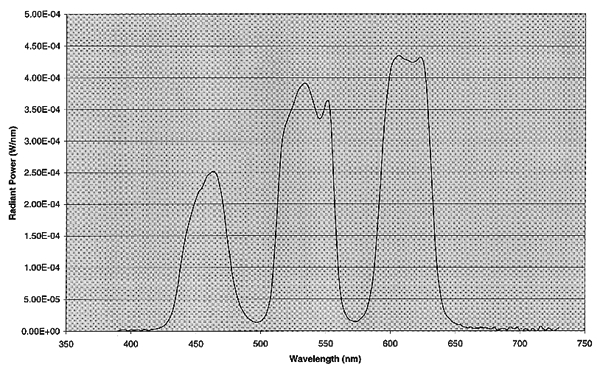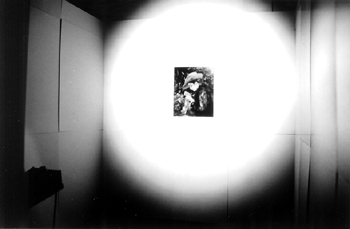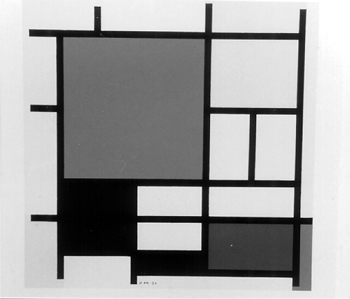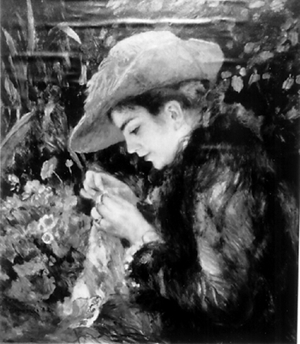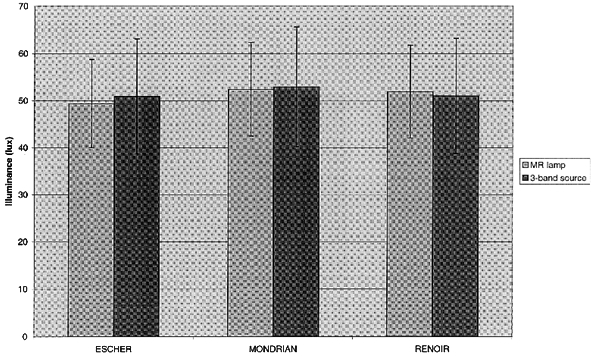A PROPOSAL TO REDUCE THE EXPOSURE TO LIGHT OF MUSEUM OBJECTS WITHOUT REDUCING ILLUMINANCE OR THE LEVEL OF VISUAL SATISFACTION OF MUSEUM VISITORSCHRISTOPHER CUTTLE
ABSTRACT—ABSTRACT—Many types of museum exhibits are susceptible to damage caused by exposure to light, and current recommendations for museum lighting include avoidance of nonvisible radiant power (UV and IR), limitation of illumination level, and restriction of exposure duration. However, these recommendations do not distinguish between the potential of incident radiant power in the visible spectrum to stimulate the sense of brightness (illuminance) and its potential to cause damage (irradiance).This article investigates the notion that the visual satisfaction provided by incandescent sources could be matched with significantly less irradiance by illumination composed of three spectral bands corresponding to red, green, and blue light. Pairs of identical artworks were displayed in two adjacent simulated art galleries, and 16 subjects adjusted the illumination in the test gallery to match the appearance of the similar display in the comparison gallery. The light source in the comparison gallery was an MR tungsten halogen display spotlight of either low (2850 K) or intermediate (4200 K) color temperature. The light source in the test gallery was either an identical MR spotlight, or it was an experimental three-band source of far lesser irradiance for which the color temperature had been matched to that in the comparison gallery.It was found that, when instructed to adjust for equality of appearance, the subjects set for equality of illuminance. For this condition, the irradiance of the artworks was significantly less for the three-band source than for either of the MR lamps. Also, at equal illuminance and color temperatures, subjects' responses indicated that they were conscious of differences in appearance between the three-band source and the MR lamps, but the difference seemed slight and they did not necessarily discriminate against the three-band source. It is concluded that a practical light source for museums could be developed that would have the potential to equal the visual satisfaction provided by incandescent lamps at a given illuminance, while exposing exhibits to significantly less irradiance, thus reducing their rate of degradation while on display. TITRE—Une solution pour r�duire l'exposition des objets de mus�e � la lumi�re sans r�duire l'�clairement lumineux ou le degr� de satisfaction visuelle du public. R�SUM�—Plusieurs genres d'expositions de mus�e sont vuln�rables � la lumi�re et les recommandations courantes pour l'�clairage sont d'exclure toute radiation invisible (l'ultraviolet et l'infrarouge) et de limiter l'�clairement et la dur�e de l'exposition � la lumi�re. Cependant, ces recommandations ne permettent pas de distinguer deux ph�nom�nes du flux �nerg�tique de la lumi�re visible incidente, lesquels peuvent causer non seulement des dommages photochimiques (dus � l'�clairement �nerg�tique), mais aussi stimuler l'effet de luminosit� (d� � l'�clairement lumineux).Cet �tude examine la th�orie qu'il est possible de reproduire une satisfaction visuelle comparable � celle �prouv�e lorsqu'on �claire les objets au moyen de lampes � incandescence, mais en utilisant un �clairement �nerg�tique plus faible, � l'aide d'un �clairage compos� de trois bandes spectrales correspondant � la lumi�re rouge, verte et bleue. Des paires d'oeuvres d'art identiques ont �t� expos�es dans deux salles d'exposition contigues, et seize personnes ont �t� choisies pour r�gler l'�clairage des objets en exposition dans la salle d'essai pour le rendre, selon elles, semblable � celui de la salle comparative voisine. La salle comparative �tait �clair�e au moyen de lampes tungsten halog�nes MR � faisceau convergent (spot) dont la temp�rature de la couleur �tait soit faible (2 850 K) ou moyenne (4 200 K). L'�clairage dans la salle d'essai �tait r�alis� soit au moyen de lampes MR � faisceau convergent (spot) identiques, soit d'une source exp�rimentale � trois bandes produisant un �clairement �nerg�tique bien moindre et dont la temp�rature de la couleur �tait r�gl�e pour coincider avec celle des lampes de la salle comparative. On a trouv� que lorsqu'on leur demandait de r�gler l'�clairage pour que l'apparence soit la m�me, les personnes cherchaient � obtenir le m�me �clairement lumineux. C'est ainsi que l'�clairement �nerg�tique au moyen des sources lumineuses � trois bandes devenait bien moindre que celui produit par les lampes MR. De plus, lorsque l'�clairage produit par les lampes MR et celui produit par les sources lumineuses � trois bandes avaient le m�me �clairement lumineux et la m�me temp�rature de couleur, les personnes rapport�rent qu'elles voyaient une diff�rence dans le r�sultat des deux types d'�clairage, mais que celle-ci leur semblait minime, et que somme toute, elles n'avaient pas d'objections vis-�-vis l'�clairage � l'aide des sources lumineuses � trois bandes. L'auteur tire la conclusion qu'il serait possible de d�velopper une source lumineuse pratique pour les mus�es, qui pourrait procurer une satisfaction visuelle tout aussi bonne que celle produite par les lampes � incadescence au m�me niveau d'�clairement lumineux, mais qui exposerait les oeuvres � un niveau d'�clairement �nerg�tique bien inf�rieur, ce qui r�duirait le taux de d�t�rioration des oeuvres en exposition. TITULO—Una propuesta para reducir la exposici�n a la luz de objetos en museos sin reducir la iluminaci�n o el nivel de satisfacci�n visual de los visitantes. RES�men: Muchos tipos de exhibiciones en museos son suceptibles al da�o que causa la exposici�n a la luz. Actualmente las recomendaciones para la iluminaci�n en museos incluyen evitar la radiaci�n no visible(ultravioleta e infraroja), limitar el nivel de iluminaci�n y restringir la duraci�n de la exposici�n. Sin embargo, estas recomendaciones no distinguen entre el potencial de la radiaci�n incidente en la regi�n visible del espectro para estimular el sentido de brillo (iluminaci�n) y su potencial para causar da�o (irradiancia). Este art'culo investiga la noci�n de que la satisfacci�n visual que proporcionan las fuentes incandescentes puede lograrse con una irradiancia significativamente m�s baja usando una iluminaci�n compuesta por tres bandas espectrales correspondientes al rojo, verde y azul respectivamente. En dos galer'as adyacentes simuladas se exhibieron pares de obras de arte id�nticas y 16 sujetos ajustaron la iluminaci�n en la galer'a de prueba para que tuviera el mismo aspecto que la galer'a de comparaci�n. La fuente de iluminaci�n en la galer'a de comparaci�n fue una l�mpara hal�gena MR de tungsteno de temperatura de color baja (2850 K) o intermedia (4200 K). La fuente de iluminaci�n en la galer'a de prueba fue una l�mpara MR id�ntica o una fuente experimental de tres bandas de mucha menor irradiancia para la cual la temperatura del color se habia ajustado a la de la galer'a de comparaci�n. Se encontr� que cuando se instruy� a los sujetos para que hicieran los ajustes necesarios para que el aspecto fuera el mismo estos lo hicieron de tal manera de lograr la misma iluminaci�n. Bajo estas condiciones, la irradiancia de las obras de arte fue significativamente m�s baja cuando se us� una fuente de tres bandas que cuando se usaron l�mparas MR. Adem�s, para las misma iluminaci�n y temperatura del color, los sujetos indicaron que eran conscientes de las diferencias de aspecto entre la fuente de tres bandas y las l�mparas MR, pero que estas diferencias les parec'an insignificantes y que no necesariamente discriminaban en contra de la fuente de tres bandas.Se concluye que se podr'a desarrollar una fuente de luz pr�ctica para museos con el potencial de igualar la satisfacci�n visual de las l�mparas incandescentes para una determinada iluminaci�n, pero sometiendo a las exhibiciones a una irradiancia significativamente mas baja y por lo tanto reduciendo la velocidad de deterioro. 1 1. INTRODUCTIONCurrent recommendations for museum lighting practice are broadly in agreement that ultraviolet (UV) should be severely restricted or eliminated and that exposure to light should be limited in both intensity and duration (CIBSE 1994; IESNA 1996). For exhibits that are categorized as highly susceptible to exposure damage, the recommended maximum illuminance is 50 lux, which is recognized as the lowest practical level for exhibits for which color discrimination is an important factor (Thomson 1986). Even when these recommendations are strictly applied, display lighting still causes permanent damage to exhibits (Feller 1967; Michalski 1987). While there are no specific standards for infrared (IR) control, dichroic reflector spotlights are generally recommended. The mirror that forms the beam for this type of spotlight has a wavelength-selective reflecting surface that directs light, but not IR, into the beam. Generally, current practice for museum display lighting utilizes incandescent filament light sources, such as the MR lamp (a tungsten halogen source with integral multifaceted dichroic reflector, usually 2 in. in diameter). The spectral power distribution for this type of illumination is characterized by a continuous, smooth curve throughout the visible spectrum, increasing toward the long-wavelength end. It used to be supposed that incandescent light sources are safe because they are weak sources of short-wavelength radiation, particularly of UV, but also at the short-wave (blue) end of the visible spectrum. However, recent studies of exposure of artist's pigments to narrow wave bands within the visible spectrum have shown that the wavelength susceptibility of a pigment is largely determined by its spectral absorption characteristic (Saunders and Kirby 1994). An artist's palette that covers a full color range inevitably includes pigments that are selective absorbers for every wave band in the visible spectrum. When nonvisible radiation has been controlled, the damage potentials of the visible radiation provided by alternative light sources may be compared in terms of irradiances at equal illuminances (Michalski 1987). Irradiance is the measure of incident radiant power density in watts per sq. m (W/m2), and illuminance is the measure of incident light density in lux, where one lux is one lumen per sq. m. The basis for comparison used in this report is to evaluate sources in terms of radiant luminous efficacy measured in lumens per radiant watt (lm/W(r)). This term should not be confused with the luminous efficacy values quoted in lamp catalogs, which are measures of lumens emitted per watt of electrical power input (lm/W). For the benefit of readers who are not familiar with lighting technology, suggestions for further reading follow the references. 1.1 1.1 LIGHTING AND THE COLOR APPEARANCES OF EXHIBITSAlthough radiant luminous efficacy provides a useful basis for comparing the damage potential of alternative light sources, it is far from being the whole story. A critical concern in museum lighting is how the illumination affects the appearance of colored materials. Consequently, this study was designed to relate the spectral power distribution of lighting to the responses of subjects viewing artworks in a simulated art gallery setting. It is necessary to review briefly the metrics that are used to specify the color rendering properties of light sources. Comparison is made to a black body, which is a theoretical substance for which the spectral distribution of radiant power emission is defined by its temperature. The correlated color temperature (CCT) of a light source is the temperature in degrees Kelvin (K) of a black body that most closely matches the color appearance of the source. At a low CCT (<3000 K), the appearance is a warm, yellowish light reminiscent of sunlight or a candle flame; at an intermediate color temperature (≈4000 K), the color appearance is a more neutral, white light; and at a high color temperature (>5000 K), the appearance is a cool, bluish white light reminiscent of sky light. The color rendering index (CRI) of a lamp is defined by a procedure that compares measurements relating to the color of the light reflected from a set of reference-colored samples illuminated by the lamp with the light reflected from the same samples when illuminated by a black body source having the same CCT as the lamp. (A different type of comparison source is used where CCT>5000 K.) If all of the samples match perfectly under both sources, the lamp is accorded a CRI of 100. Any departures from a perfect match reduce the CRI. This procedure assumes that, for low and intermediate color temperatures, the theoretical black body is the ideal color rendering source. The black body source is luminous because it is incandescent, and its relative spectral power distribution almost exactly matches that of an electric incandescent lamp at the same CCT. Incandescent lamps are quoted to have CRI values of 99 or 100, and are widely perceived to be perfect color rendering lamps, but this perception needs to be qualified. They are perfect only in that the color appearances of illuminated surfaces match the appearances that they would have if illuminated by a black body of the same low color temperature. It is well understood by lamp manufacturers that it is not necessary to match the spectral power distribution of a black body to achieve a high CRI value. Triphosphor fluorescent lamps concentrate their radiant power emission into three spectral bands, and there are lamps of this type that achieve high CRI values. The development of these lamps followed from basic research by William Thornton (1974; 1975; Thornton et al. 1975), who had identified three optimal wavelengths for matching the lamplight from broad spectrum sources, such as incandescent lamps, and achieving this result with high luminous efficacy and high CRI. The band center wavelengths are approximately 450 nm, 530 nm, and 610 nm, and the light of these wavelengths has the characteristic colors of blue, green, and red, respectively. Thornton also claimed that, compared with broad spectrum sources, lamplight composed of these “prime colors” has greater “visual clarity,” and, because of this characteristic, less illuminance is required for equal visual satisfaction (Thornton 1975, 38). Although triphosphor fluorescent lamps have become widely used for many lighting applications with less demanding visual requirements, they have not been generally accepted for museum lighting. There probably are several good reasons for this. Exhibition designers like the compactness of the modern incandescent lamps, and the range of beam spreads available, and the ability to focus them, and the ease of dimming them … the list goes on. Exhibition designers are not likely to give up all of these advantages over fluorescent lamps even though the fluorescent lamps may be much more efficient. However, Garry Thomson has criticized the use of Thornton's “prime color” illumination for museum applications on the basis of color rendering and has commented that prime color illumination “amounts to distortion and so might be undesirable” (Thomson 1978, 178). As triphosphor lamps improved, he later added, “There will be certain museum situations not demanding the best color rendering where they will be the choice” (Thomson 1986, 207). The author's own studies of spectral power distributions found that, at equal illuminances (lux) and the same color temperature, the irradiance (W/m2) for a three-band source may be as much as 40% less than for an incandescent lamp. This finding suggests that there is scope to significantly reduce the irradiance of exhibits without reducing the illuminance. If the irradiance can be reduced, it can be expected that the rate of damage will be correspondingly reduced, as it is irradiance that determines the damage potential for radiant energy within the visible spectrum. This theory leads to the first research question: Is the “distortion” of color rendering acceptable? If it can be shown that it is acceptable, at least in some situations, the second question becomes: Can a light source be produced that provides this conservation advantage and meets needs of exhibition designers? 1.2 1.2 RESEARCH OBJECTIVESThe aim of the experiment was to address the first research question stated above. An experimental situation was constructed to obtain paired comparison subjective assessments of a range of artworks illuminated alternately by a tungsten halogen multifaceted reflector (MR) spotlight and by an experimental three-band source, both having the same correlated color temperature. It was predictable that the CCT and the color appearance of an MR lamp could be matched by a three-band source that would have significantly higher radiant luminous efficacy (lm/W(r)) than the MR lamp. It was expected that if subjects were presented with an achromatic scene alternately lit to the same illuminance by these two types of light source, the subjects would not differentiate between the two presentations. What could not be predicted was how they would respond to a scene that involved colored materials. The basis for the comparison was an illuminance of 50 lux on the artwork provided by an MR spotlight, as this the type of lighting and light level are widely adopted for display of susceptible exhibits. However, the CCT of the MR lamp is low: 3000 K at full voltage, and in practice often lower due to being dimmed to provide 50 lux. It was decided that the experiment should also include an intermediate color temperature source, and this was achieved by repeating the procedure using a new type of MR lamp that has a CCT of 4700 K at full voltage. 2 2. METHODS AND MATERIALSThe experiment consisted of identical reproductions of artwork presented in two adjacent simulated art gallery settings, one the test situation and the other the comparison situation. Subjects adjusted the illuminance in the test situation to match the appearance of the comparison situation. The comparison situation was always illuminated to 50 lux by an MR lamp, and the test situation was illuminated alternately by an MR lamp and an experimental three-band light source. The settings were recorded and compared to see whether there were differences in the illuminances that subjects selected to achieve similar appearances. Differences of irradiance were calculated from the recorded illuminances. Also, subjects were questioned on any differences of appearance they noticed after making each setting. 2.1 2.1 THE three-band LIGHT SOURCEFigure 1 shows the spectral power distribution for an MR16 20/12 BAB/FL/40 lamp operating on slightly reduced voltage to provide 50 lux in the experimental situation with a CCT of 2850 K. Note the characteristic smooth, continuous curve climbing toward the long-wavelength end of the spectrum. The decline above 700 nm is due to the dichroic reflector, which is partially transparent to IR and extreme long-wavelength visible radiation. All spectral power distribution measurements were made with an Oriel Instruments model 7740 spectroradiometer.
While a practical three-band light source for museum use will consist of a single lamp, with or without a filter, for the experimental situation the three bands were provided by separate lamps, each with a band-pass filter. The band center wavelengths identified by Thornton are at 80 nm intervals, and three types of 50 mm diameter, 40 nm band pass filters were obtained. The 450 nm filter was available as a stock item, but the 530 nm and 610 nm filters were custom items. The filters were mounted in compact industrial luminaire housings fitted with 50 watt MR lamps. Because of the low radiant power from these lamps at short visible wavelengths, it was necessary to use two 450 nm sources. Figure 2 shows the spectral power distribution for these lamp and filter combinations with their outputs balanced to match the CCT of the source shown in figure 1. The difference in the SPD curves is strikingly obvious: not only are the end parts of the visible spectrum missing, but also there are two deep notches in the curve. Data for the MR and the three-band sources are given in table 1, from which it can be seen that the radiant luminous efficacy for the three-band source is 70% higher than that for the MR lamp. This result means that at equal illuminances (lux), the three-band source will produce 41% less irradiance (W/m2).
The process of adjusting the balance of the three wave bands of the experimental source was tedious and time consuming. However, the experimental procedure required the three-band source to be dimmable, which created a problem: how to vary the output of the source while maintaining the balance of the wave bands. The problem was solved by a feedback device that was developed specially for this experiment. Each lamp housing was fitted with a light sensor directed toward the lamp. The sensors were connected to the feedback device, a custom electronic circuit that continually monitored the outputs of the lamps and maintained them in constant ratios. The control operated by the subject changed the output of the mid-wave-band lamp, and the feedback device made instantaneous proportional changes to the lamp outputs for the other two wave bands. By operating a switch outside the test room, the experimenter selected whether the subject's control operated the three-band source or the MR lamp, so that the subject was given no obvious indication of which type of light source was in use. The first phase of the experiment was completed using low CCT (approximately 2850 K) sources. For the second phase, the regular MR lamps were replaced with 12 volt, 50 watt “SoLux” MR lamps, which were dimmed to provide 50 lux at approximately 4200 K. Figure 3 shows the spectral power distribution and the loss of long-wavelength power to achieve the higher CCT is apparent. The three-band source was adjusted to match this CCT, and the spectral power distribution is shown in figure 4. Data for these sources are also shown in table 1, and for this higher color temperature the radiant luminous efficacy for the three-band source is 46% higher than for the MR lamp. The main reason this difference is less than for the low color temperature case is that the radiant luminous efficacy of the MR lamp is higher. However, this property does not result because it is a more efficient lamp, but because less radiant power is emitted at the long-wavelength end of the visible spectrum, where the luminous efficiency is very low.
2.2 2.2 EXPERIMENTAL DESIGNThe experimental design called for a pair of identical “art gallery” settings to be viewed sequentially. An important aspect of the museum viewing experience is that the viewer visually adapts to the ambient illumination, and this adaptation would not be achieved by side-by-side viewing or any other form of simultaneous presentation. Two adjacent partitioned offices measuring 8 ft. 6 in. by 6 ft. 9 in. by 7 ft. high were lined with white Fome-core, and three pairs of identical prints of artworks were presented in these simulated “art gallery” settings. Figure 5 shows one of the settings. The artworks selected were:
The comparison situation was lit by an MR lamp that was preset by the experimenter to an illuminance of 50 lux. The test situation was lit alternately by an MR lamp identical to the one in the comparison situation, or by the three-band source adjusted to have CCT and chromaticity matched to the comparison source. The arrangement of the light sources in the test room, including the sensors connected to the feedback device, is shown in figure 9.
The subjects were each taken to the comparison situation, where one of the artworks was on display at the preset illuminance. They were instructed to suppose that this was an art gallery and that they had come to see this picture. Then they were taken to the test situation, where the identical artwork was on display, and they were told to adjust the control “to match the appearance of this situation as closely as possible to the appearance of the previous situation.” Subjects could return to the comparison situation as often as they wished, but could not view the two situations simultaneously. When a setting had been made, the experimenter recorded the control reading and asked if the subject could see any differences between the two situations, using five categories of difference:
A 7-point scale was used to describe the magnitude of the difference of appearance of the test situation relative to the comparison situation: +3 = much more; +2 = more; +1 = slightly more; 0 = no difference; −1 = slightly less; −2 = less; −3 = much less. For each phase of the experiment, subjects made six settings, one for each of the two sources illuminating each of the three artworks. The order of presentations was randomized for each subject. The light source CCT was approximately 2850 K for the first phase, and subjects returned to repeat the procedure for the second phase, for which the CCT was approximately 4200 K. Light source data are given in table 1. 3 3. RESULTS AND DISCUSSIONSixteen subjects completed both phases of the experiment. They were staff and students at the Lighting Research Center, but did not include faculty or others who had foreknowledge of the experiment. There were 6 males and 10 females. 3.1 3.1 ILLUMINANCE SETTINGSTable 2 shows means and standard deviations for the illuminance settings made by the subjects in the test situation, and these data are illustrated in figures 10 and 11. In every case the illuminance in the comparison situation was preset to 50 lux, and it is apparent that subjects set the illuminance in the test situation to match the illuminance in the comparison situation.
3.2 3.2 ASSESSMENTS OF APPEARANCETables 3–8 show the distributions of the subjects' assessments of the appearance of the experimental condition in the test situation relative to the matching condition in the comparison situation. It can be seen that there are few instances of subjects reporting anything more than a slight difference between the appearances of the two rooms. In fact, all of the mean values correspond to fractional parts of a slight difference, and in many cases the reported difference of appearance between the three-band source and the comparison MR source was less than the reported difference between identical MR sources.
The brightness and clarity criteria attracted very few comments from the subjects. The color appearance of the Escher print illuminated by the three-band source attracted several comments. Some subjects who rated the difference favorably described the test situation as appearing “more white,” while others who rated it unfavorably criticized the nonuniformity of color appearance. Despite painstaking adjustment, the blending of the colored light sources in the test situation was imperfect, and this shortcoming was more evident when viewing the achromatic print than when viewing the chromatic artworks. The color appearance of the Mondrian illuminated by the three-band source also attracted comments. The colors were described as “less vivid” or “faded,” particularly the red pigment. However, at the lower CCT there was some favorable comment that the blue pigment appeared brighter, and also unfavorable comment that there was an overall cooler appearance. These comments are understandable. Incandescent filament lighting enhances the apparent saturation of red colored surfaces, particularly at the lower CCT, and reduces the apparent saturation of blue surface colors. The appearance of the Renoir painting under the three-band source attracted a variety of both favorable and unfavorable comments. At the lower CCT, favorable assessments (“colors seem to look better”) were matched by unfavorable assessments (colors “more washed out”). At the higher CCT, flesh tones were criticized. 3.3 3.3 DISCUSSION OF RESULTSSubjects had been instructed to match the appearance of the test gallery to the comparison gallery. Thornton would have predicted that they would select a lower illuminance for the three-band source because, he claims, this source has greater visual clarity; but this was not the case. The subjects matched the illuminance in the test gallery to the illuminance in the comparison gallery in every case, indicating that illuminance effectively evaluated the overall sense of equality of appearance despite the very different spectral compositions of the two types of lighting. The fact that the three-band source provides a given illuminance with substantially lower irradiance on the illuminated object offers a significant benefit for conservation. For the light sources used in the experiment, the irradiances in watts per square meter (W/m2) to provide 50 lux on the artworks are shown in table 9.
It is conventional to assess the exposure of illuminated museum exhibits in terms of lux hours per year (lx h/y), so that an object lit to 50 lux and exhibited for 3,000 hours per year is exposed to 150,000 lx h/y (IESNA 1996). This measure does not distinguish between the different irradiances of light sources at the same illuminance. If the light source in this example is a regular MR lamp, then changing to a three-band source at the same illuminance would reduce the exposure by 41% and would be equivalent to only 89,000 lx h/y of exposure to the regular MR lamp. Looked at another way, it would take 1.7 years of exposure to the low CCT three-band source to subject the object to the same effective exposure as would occur in one year with a regular MR lamp at the same illuminance. For the intermediate CCT sources, it would take 1.4 years. Although the color temperatures of the MR and three-band sources had been carefully matched, it should not be supposed that their color rendering would be identical. The direction of the study was to assess whether, when matched for overall appearance, the three-band source would be an acceptable alternative to the MR lamp. As has been explained, incandescent lamps score high on the color rendering index scale because they have continuous spectral power distributions that closely match the reference sources that represent a CRI score of 100. Particularly at the lower color temperature, incandescent sources emit strongly at the long-wavelength end of the visible spectrum, which has the effect of increasing the vividness of red pigments and poses the question, what is meant by color distortion? Because the standard is a black-body reference source, for any low CCT source to achieve a high CRI rating it must have strong emission at the long-wavelength end of the visible spectrum. This emission will have the visible effect of enhancing the appearance of red pigments and making flesh tones appear warmer. This difference was recognized by the subjects and attracted a variety of comments concerning the appearance of the Mondrian and Renoir paintings. The comments were not necessarily unfavorable toward the three-band source, and whether it is appropriate to treat incandescent sources as the standard for color rendering is questionable, particularly at low color temperatures. At least we can be fairly confident that the artists did not paint these works under incandescent lighting. The subjects' rating data are not suitable for elaborate statistical analysis because the scaling interval is arbitrary, that is to say, the interval between no difference (0) and slightly more (+1) is not necessarily equal to the difference between more (+2) and much more (+3). A simple comparison of the subjects' assessments in terms of average ratings assumes that a rating of −2 is canceled by another rating of +2. This is not an unreasonable approach to gaining an overall indication of acceptability, but examination of the data shows that there was a greater scatter of ratings for the three-band source. This difference is indicated by comparing the mean sum of squares for the experimental conditions, shown in tables 10 and 11. A rating of either −2 or +2 adds 4 to the sum of squares, from which the mean value for the data set is calculated. Table 10 shows that, for all artworks, there was little variation in the ratings of brightness difference, but for all of the other criteria the scatter of ratings was greater for the three-band source than for the MR lamp. Subjects had made the adjustment for equality of appearance, and the impression of brightness was not different for the two types of light source. However, subjects were conscious that the three-band source was different from the MR lamp. They rated it to be different for color appearance and for the sense of clarity and naturalness, but their comments did not indicate discrimination against the three-band source. Table 11 shows the mean sum of squares for all five criteria for each of the three artworks, and in every case the scatter of ratings was greater for the three-band source. A reason for the achromatic artwork's being assessed differently for color appearance has been mentioned, and it seems likely that it was less influential for the two chromatic artworks.
Moving on to consider the second research question, there are two approaches to developing practical light sources that could gain the conservation advantage of the three-band source. A new type of filter could be developed that would convert the continuous spectrum of a regular MR lamp into a three-band spectrum. While this filter would achieve high radiant luminous efficacy (lm/W(r)), the luminous efficacy of the lighting system in terms of lumens per watt of electrical power input would be poor. It must be recognized that whenever a filter is added to a lamp, it is necessary to increase the lamp wattage to maintain the illuminance. A more efficient approach would be to develop a new lamp type specifically for museum applications in which a three-band spectrum is generated by efficient conversion of electrical power. While this latter approach offers the prospect of a superior solution, the development costs are likely to be much higher. It should not be presumed that the museum community will respond with enthusiasm to this initiative. There is a long history of museum directors, particularly art museum directors, insisting that natural light is the only true light for the museum experience. The distinctly unnatural spectral power distribution of the three-band source favored by this study is likely to be regarded with strong suspicion, whatever the visible difference in the lighting. A further study in a real art gallery directed toward gaining critical evaluations of museum professionals is recommended. 4 4. CONCLUSIONSThree main conclusions emerge:
ACKNOWLEDGEMENTSThis project was funded by the National Center for Preservation Technology and Training, Northwestern State University, NSU Box 5682, Natchitoches, La. 71497. The research was conducted at the Lighting Research Center, Rensselaer Polytechnic Institute, Troy, N.Y. 12180–3590. REFERENCESCIBSE. 1994. Lighting Guide LG8: Lighting for museums and art galleries. London: Chartered Institution of Building Services Engineers. Feller, R. L.1967. Control of deteriorating effects of light on museum objects: Heating effects of illumination by incandescent lamps. Museum News: 46(9):39–47. IESNA. 1996. Museum and art gallery lighting: A recommended practice. New York: Illuminating Engineering Society of North America. Michalski, S.1987. Damage to museum objects by visible radiation and ultraviolet radiation. Proceedings of the Conference on Lighting Museums, Galleries and Historic Houses. London: Museums Association. 1–16. Saunders, D., and J.Kirby. 1994. Wavelength-dependent fading of artist's pigments. In Preventive conservation: Practice, theory and research, ed. A.Roy and P.Smith. London: International Institute for Conservation. 190–94. Thornton, W. A.1974. Lamps for assessing metamerism. Journal Illuminating Engineering Society3(2):11–18. Thornton, W. A.1975. The high visual efficiency of prime color lamps. Lighting Design & Application5(11): 35–41. Thornton, W. A., R.Corth, and G. S.Evans. 1975. Fluorescent light sources. Lighting Design & Application5(10):6–14. Thomson, G.1978. The museum environment.London: Butterworths. Thomson, G.1986. The museum environment.2d ed.London: Butterworths. FURTHER READINGCoaton, J. R., and A. M.Marsden, eds. 1997. Lamps and lighting.4th ed.London: Arnold. A readable and up-to-date text on electric lighting. Cuttle, C.1996. Damage to museum objects due to light exposure. Lighting Research and Technology8(1):1–9. Rea, M. S., ed. 1999. Lighting handbook.9th ed.New York: Illuminating Engineering Society of North America. A comprehensive reference work covering fundamentals, principles, and applications of lighting. Thornton, W. A.1992. Towards a more accurate and extensible colorimetry (Parts 1–3). Color Research and Application17(2):79–122; 17(3):162–86; 17(4):240–62. A treatise on the theoretical basis of the prime colors concept. AUTHOR INFORMATIONCHRISTOPHER “KIT” CUTTLE, MA, FCIBSE, FIESANZ, FIESNA, LC, is senior lecturer in architectural technology at the School of Architecture, University of Auckland, Auckland, New Zealand. He started his career with a lighting manufacturer in London, and worked for DPA Lighting Consultants before joining the Daylight Advisory Service of Pilkington Glass, UK. It was here that he developed his interest in museum lighting, and over the years he has lectured and published several papers on the topic. In 1976 he took an academic position with Victoria University of Wellington, New Zealand, and in 1990 he became head of Graduate Education in Lighting at the Lighting Research Center, Rensselaer Polytechnic Institute, Troy, New York. He moved to his present position in New Zealand in 1999. Address: School of Architecture, University of Auckland, Private Bag 92019, Auckland, New Zealand. E-mail: kcuttle@auckland.ac.nz Received for review February 17, 1999. Revised manuscript received December 21, 1999. Accepted for publication January 19, 2000.
 Section Index Section Index |

